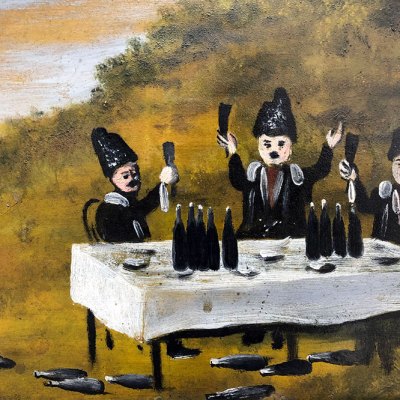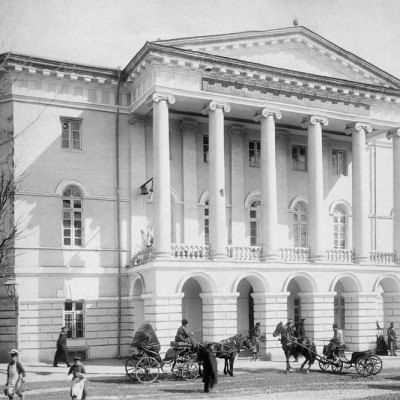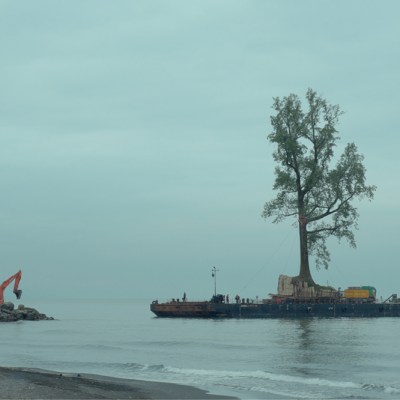From the January 2022 issue of Apollo. Preview and subscribe here.
Centuries ago, the story goes, when the once-glorious Kingdom of Georgia was under attack from foreign enemies, patriotic art-lovers sent its treasures to the mountain fastness of Svaneti – a place no Mongol horde or Persian army could ever reach. Since then the treasure, an Aladdin’s Cave of sacred icons, illuminated holy books, golden crosses and sumptuous textiles, has been preserved. Protected by 5,000m mountains and guarded by the warlike Svan people, these relics of a Golden Age have come down to us today and are now on display in the newly rebuilt Svaneti Museum of History and Ethnography in the main village, Mestia, where they are admired by tourists on days when the weather is too bad for hiking.
This legend of Svaneti as some sort of medieval Fort Knox of the mountains has become so widespread that it appears in all the guidebooks, is repeated by every taxi driver, and has been internalised by many Svans themselves – a fitting tale for an ancient people with their own language and traditions, related to but distinct from ordinary Georgians. The Svan language broke away from what would become Georgian some 3,000 years ago, and the Svans have remained distinct since then, retaining their own traditions and customs. While always a part of a larger Georgian people, Svaneti was often left to manage its own affairs by the powers that be in the lowlands. They and other highland Georgian tribes are often romanticised as ‘pure’, untainted ur-Georgians – just the sort of people who should look after the national treasury in times of war. But, according to Salome Guruli, who led the project to reconstruct the Svaneti Museum, as is often the case with this kind of tale, ‘There is no truth to the legend.’
For Guruli, who is Svan, and who worked for years to build a world-class, modern museum in this remote corner of the Caucasus, the story is actually slightly galling. ‘The whole concept of the newly renovated museum is to show that Svaneti is not just some store house for all this treasure – this was a place involved in the creation of this art.’
When you look around the collection, it’s no wonder the legend has stuck. The museum holds some 5,000 medieval objects along with a vast trove of archaeological and ethnographic items. Even this is only a fraction of the art preserved in Svaneti – the whole region is studded with frescoed churches full of icons and other precious items. Tour guides can be forgiven for repeating a just-so story of how this tiny place, just two mountain valleys, historically inaccessible for most of the year and now home to about 10,000 people, came to house one of the world’s greatest collections of medieval Christian art.
Incense burner decorated with scenes of the life of Christ (5th/7th century), Syria. Svaneti Museum of History and Ethnography, Mestia

On display in the museum are many ‘foreign’ objects, from lowland Georgia and beyond. These include a 13th-century painted altar cross from Venice, encrusted with pearls (see page 11); Syrian incense burners from around the sixth century, the repoussé scenes from the life of Christ almost rubbed away; embroidered Byzantine icons; a superb Seljuk Syrian textile of opposing griffons surrounded by Kufic script, repurposed to wrap a pre-altar crucifix. But rather than being sent up for safekeeping, Guruli explains, they were objects of prestige donated by families and individuals to one of the hundreds of churches that dot the mountainsides. ‘Almost all these objects, for example the archaeological, the numismatic, even the ethnographic collection – all of them were donated to the churches,’ Guruli says.
Textile for wrapping a pre-altar cross (11th–12th century), Syria. Svaneti Museum of History and Ethnography, Mestia

There are records of many of these donations. Marginalia in the museum’s priceless illuminated manuscripts, some of which were made in Georgian monasteries in Jerusalem, list church donors, local history and legal disputes (one set of gospels from the ancient province of Tao, now in eastern Turkey, can claim a sort of refugee status – they were brought to Svaneti by a noble family who were forced to relocate as a result of one of the interminable Georgian-Byzantine wars of the early 10th century, the period when an independent Georgia was moving out of Constantinople’s orbit and carving out a kingdom, then an empire, for itself). Epigraphs on other objects show their provenance, including an Iranian pitcher donated by Georgia’s most beloved monarch, the heroic Queen Tamar, who reigned 1184–1213, and another one donated by her less successful father, Giorgi III.
Pitcher (13th century), Iran. Svaneti Museum of History and Ethnography, Mestia

But it is the donations by Svan artists themselves that make the museum’s collection so unique; after all, there are plenty of Venetian crosses in Venice. These works testify to a time when Svaneti was a cultural powerhouse with local schools of metalwork, icon painting and frescoes – much of which has come down to us today. The three Gvazavaisdze brothers, genius Svan metal-chasers of the 11th century, have epigraphs entreating the Lord to redeem their sins on icons of such technical skill and personal expressiveness that they feel more like Renaissance paintings. Ipari, the tiny village from where the Gvazavaisdzes may have come, is the source of more masterpieces, Saint Barbara looking straight through you, and multiple instances of St George, patron saint of Georgia, skewering the Roman emperor Diocletian through the guts (a popular image in Svaneti, most likely another result of the Georgian-Byzantine wars).
Icon of Saint Barbara (11th century), Ipari commune, Svaneti. Svaneti Museum of History and Ethnography, Mestia

The painted icon school that flourished a century after the Gvazavaisdze brothers chased their metal departs markedly from the orthodox visual language of the lowlands. Exquisite but formal icons from lowland Georgia, such as a 12th-century rendition of the Forty Martyrs of Sebaste, each martyr an individual freezing to death in his own way, soon give way to a stylised local language of elongated features and huge eyes whose lids never quite meet in the corners. These icons speak of the independent spirit of the Svans and their unique take on orthodox Christianity, which incorporates much pagan material. While Christianity became the state religion in eastern Georgia in the early fourth century, it was another 200 years till an unknown evangelist brought it to Svaneti. In the mountains, far from centralised ecclesiastical authority, the new faith blended with local beliefs: saints took on the attributes and sacred sited of the pre-Christian pantheon, and pagan rituals found new meanings. Even today Svans, while dedicated believers, often treat clerics from the lowlands with a degree of scepticism unusual in the rest of Georgia.
The Prophet Jonah (12th/13th century), Svan School. Svaneti Museum of History and Ethnography, Mestia

It was in the period between the 11th and the 13th century, the golden age of medieval Georgia, that Svaneti developed its indigenous schools of devotional art. At this time, it was a crucial part of a muscular, united Georgian monarchy that spread its culture and religion across the Caucasus. This imperium, running from what is now central Turkey to the Caspian Sea, reached its apogee under Queen Tamar, a saint of the Georgian Church and a sort of culture hero in Svaneti, where some believe she was secretly buried. Under the monarchs of the Golden Age Svaneti was important from both a strategic and an economic point of view, home as it is to rich gold deposits. Another tour-guide favourite is the story of how the Svan practice of panning for gold using sheepskins is the source of the myth of the Golden Fleece, a theory first posited by the Greek geographer Strabo 2,000 years ago, and even today the locals extract gold from rushing mountain streams in just this fashion. Most of the golden objects in Georgian museums were made with gold from Svaneti.
Along with all the art, this period also saw the construction of the much-celebrated Svan towers, slender five-storey fortresses which cluster together in villages, like militarised mushrooms, giving the entire region a kind of high-fantasy quality that would make Tolkien blush. Traditionally, each family would have its own tower, which would afford protection from avalanches – and from the perennially feuding neighbours. In addition, each clan would have its own church, resulting in a profusion of small, single nave chapels, many richly frescoed by named masters, as well as some larger and grander churches. These places of worship received, and still receive, everything from gold coins to bows and arrows, bronze age objects found in fields to handmade furniture – pledged to atone for sins, to seek cures for the sick and to give thanks for victory in battle.
Weakened by the Mongols and then devastated by the Black Death and the armies of Tamerlane, by the late medieval period the Golden Age was well and truly over, with Georgia split into fractious, feuding statelets. Further invasions by the Ottomans, the Safavids and assorted nomadic tribes caused huge destruction. But Svaneti, unlike the rest of Georgia, was never invaded and occupied – indeed the Svans effectively closed off the region from the outside world until the Russians began to show up in the mid 19th century. Thus it was here, more so than in the rest of the country, that the treasures remained in the churches, with icons stacked deep against the frescoed walls, all locked behind fabulously carved medieval doors. The Russians, being Orthodox Christians and having only the loosest grasp on the region, were happy to leave the treasure where it was. And there it remained, at least until the 1930s when art historians and archaeologists began the delicate process of negotiating to move some of the most important and most at risk items into a museum – the ancestor of today’s Svaneti Museum.
It was Egnate Gabliani, a native of Mestia who had graduated from the University of St Petersburg, who established the museum, along with Giorgi Chubinashvili, the founding father of Georgian art history, who assembled much of the collection. Gabliani succeeded in founding the museum because of the huge local respect he enjoyed. Not only had he fought against the Bolsheviks when they annexed Georgia in 1921, but he subsequently managed to convince them to build a motorable road connecting Mestia with the rest of Georgia – it is still the only road into Svaneti. His great niece, Tsiala Gabliani, a formidable and beloved teacher of English in the local school, explains how he was able to assemble the beginnings of the museum collection. ‘The icons were very difficult to gather, because all the villagers wanted to have their own icons and treasure in their own churches. There was a negotiation between them, and all the villagers appreciated him because he made the road, everybody respected him.’
Even in the atheist Soviet Union tension surrounded the question of where religious objects belonged and to whom they really belonged: the church, the nation, the clan that had guarded them for centuries or Svaneti as a whole. Negotiating the transfer of sacred items that had been in churches was a delicate process: these were not only valuable but offered divine protection to the entire clan or village associated with that church. The museum overcame resistance by pitching itself as the best way to protect the items for future, embodying the Svans’ collective sense of guardianship of the treasury. When Mestia’s sister museum in opened in the 1980s in Ushguli, a Unesco World Heritage Site and the highest village in Svaneti, reluctant locals extracted solemn promises sworn on the holy icons themselves that they would be safe in their museum home, and never leave the village except for conservation purposes – that promise has been kept.
Little by little, Gabliani gathered the items. He added them to the icons already stored in an expropriated church in the centre of Mestia, which in 1936 became the first museum in Svaneti – essentially a scientific institution, open storage that could only be visited by appointment. But Gabliani was never able to see his work come to fruition: he was arrested in 1937 and executed as part of the great purge. Stalin was especially cruel towards elites from his homeland of Georgia; it is likely that Gabliani’s local prestige and previous anti-Bolshevik activity signed his death warrant. ‘We could not dare to speak about him,’ Tsiala says. He was rehabilitated in the 1980s and has now regained his rightful place in the history of the region.
The Mestia Gospels (1033). Svaneti Museum of History and Ethnography, Mestia

By 1970 a less murderous and more tourist-oriented Soviet government decided that the treasures of Svaneti deserved a better home, and a competition awarded the commission to the architect Ramaz Kiknadze. The resulting project was for a brutalist take on traditional Svan architecture, a solid, semi-fortified mass clad in the local travertine. The design deservedly won numerous awards. However, this being the era of stagnation in the Soviet Union, there were some issues during construction. ‘It was a bit prolonged,’ Guruli says. ‘It took 30 years. There was a flat roof that was immediately damaged. This building had a lot of problems.’ In an apt metaphor for the Soviet Union’s attempt to build communism, the Svaneti Museum was collapsing before it was even finished.
With the chaos that engulfed Georgia following independence in 1991, Svaneti once again closed itself off from the outside world, developing a reputation for violence and kidnapping that kept all but the most intrepid art lover away. Work on the museum continued at a snail’s pace, and the collection was finally moved into its new home in 2003 – the year of the democratic Rose Revolution. By now, however, the building was falling to pieces. ‘The climate was not good. In the winter the museum had to close, it was damp. The icons were exposed, the manuscripts were stored in plastic bags, there was only one restroom,’ Guruli enumerates. The new government, who had managed to remove the armed groups and kidnappers from Svaneti, opening it up to tourists, brought the museum under a new, country-wide National Museum of Georgia, and they took the decision to rebuild. Just eight years after it had opened, the Svaneti Museum was demolished down to its foundations, and work started again, this time to a new design by the son of the original architect. Using the same footprint and the same ideas, the newly built museum finally opened its doors in 2014. It is still solid and stone clad, but also light and modern. With the Soviet marble flooring from the old building now adorning the patio of a nearby guesthouse, the interior is polished concrete and muted wood. The basement holds proper storage and conservation labs, while the objects themselves are given space to shine, each individually lit and thoughtfully displayed. It is a thoroughly modern museum, an improbable visitor in a village of medieval towers, which looks as if it has beamed down from the museum-studies mothership, circling in orbit above.
Now, for the first time in centuries, the treasures of Svaneti can be appreciated by anyone who makes the pilgrimage. More importantly, the museum is a source of pride for the Svans, the producers of most of the items and millennia-long custodians of the rest, who finally have their patrimony displayed in secure and appropriate surroundings. Safe, it is to be hoped, for another thousand years.
From the January 2022 issue of Apollo. Preview and subscribe here.


